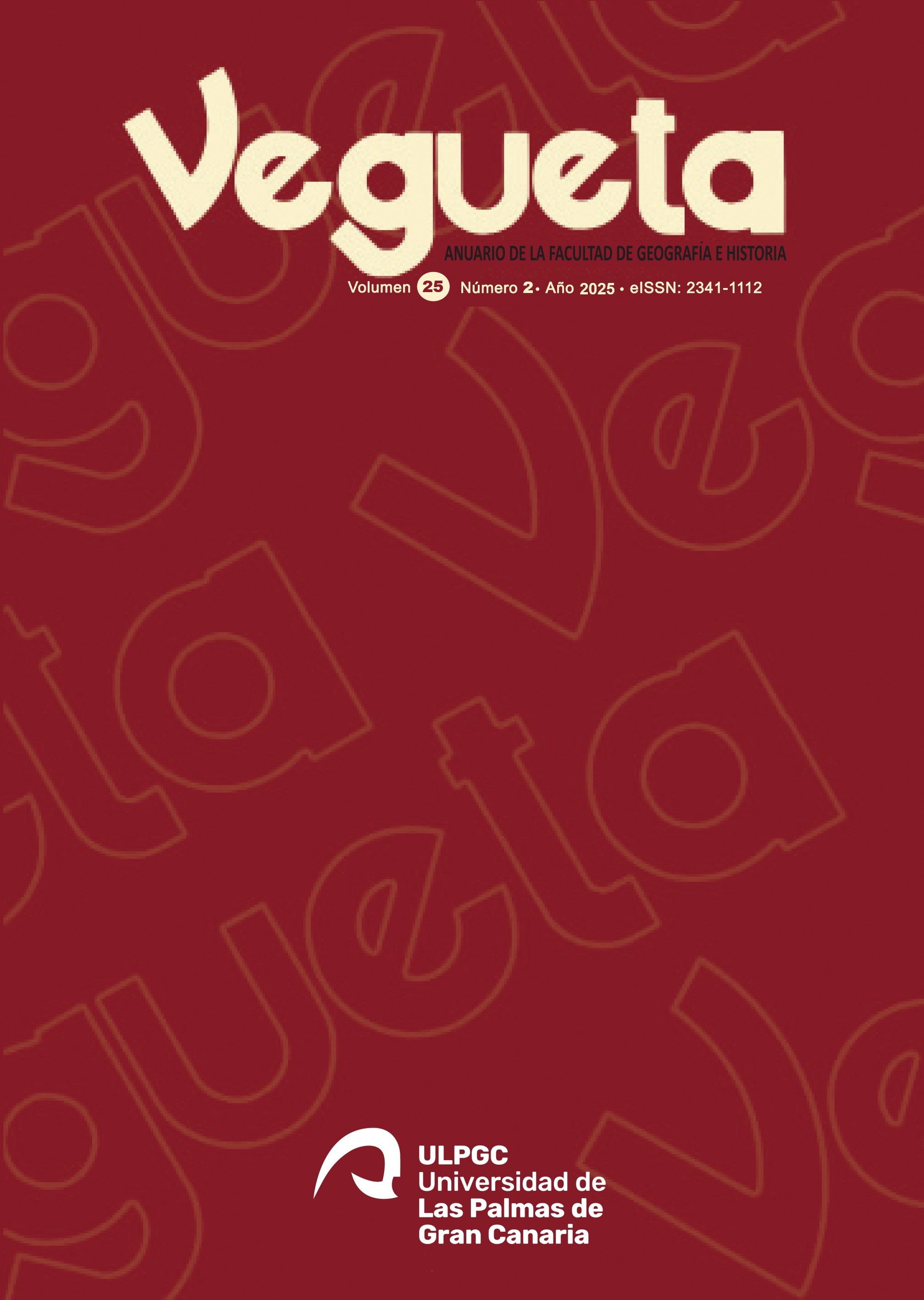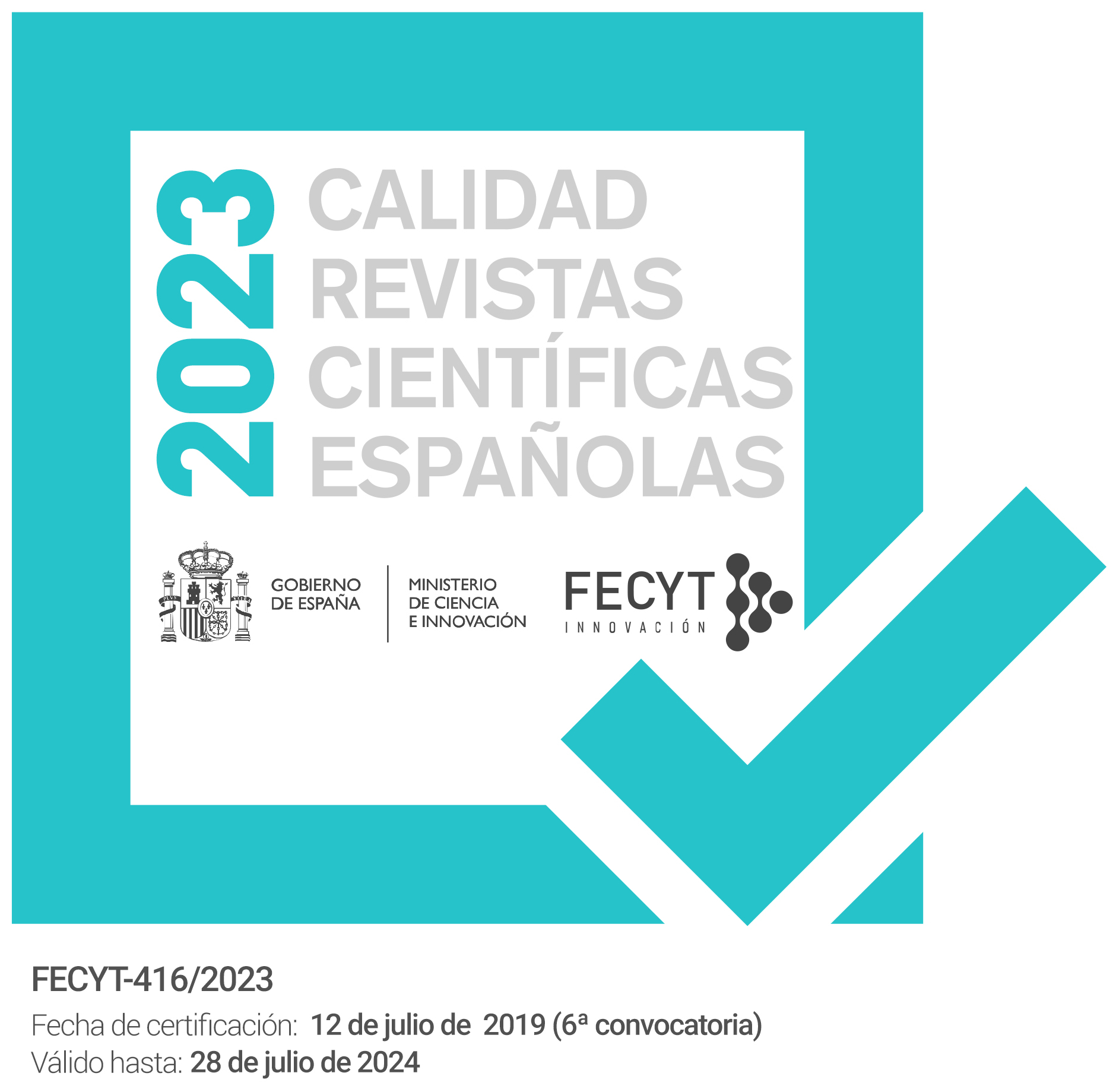Aplicación de un protocolo de inspección visual para la evaluación del estado de conservación de tintas metaloácidas, en documentos notariales, judiciales y conventuales del siglo XVI
DOI:
https://doi.org/10.51349/veg.2025.2.22Palabras clave:
protocolo de inspección, tintas metaloácidas, corrosión, AHPT, documentos históricosResumen
Este trabajo aborda la evaluación del estado de conservación de las tintas metaloácidas en una selección de documentos históricos datados en el siglo xvi almacenados en el Archivo Histórico Provincial de Santa Cruz de Tenerife. Estas tintas presentan desafíos de conservación debido a la corrosión que sufren. La investigación describe los protocolos de inspección para evaluar el deterioro de las tintas. Y se aplica en manuscritos notariales, judiciales y conventuales, clasificando su estado en cuatro condiciones de bueno a malo. Los resultados revelan que muchos documentos presentan signos de corrosión, lo que resalta la urgencia de implementar medidas de conservación adecuadas para preservar este patrimonio.
Descargas
Citas
Albro, S.; Biggs, J.L.; Dekle, C.; Haude, M.E.; Karnes, C.; Khan, Y. (2008). Developing Guidelines for iron-gall ink treatment at the Library of Congress. The Book and Paper Group Annual 27, 129-165. https://cool.culturalheritage.org/coolaic/sg/bpg/annual/v27/bpga27-20.pdf
Cabrera Valenciano, Mª Iluminada. (2009). Los archivos notariales en Canarias. Historia de los Archivos en Canarias Tomo I. pp. 297-358
Dekle, C.; Haude, M. E. Iron gall ink treatment at the Library of Congress: Old manuscripts-New tools. (2008). The Book and Paper Group Annual 27, 15-26. https://cool.culturalheritage.org/coolaic/sg/bpg/annual/v27/bpga27-04.pdf
Díaz Hidalgo, R.J.; Córdoba, R.; Nabais, P.; Silva, V.; Melo, M.J.; Pina, F.; Teixeira, N.; Freitas, V. (2018). New insights into iron-gall inks through the use of historically accurate reconstructions. Heritage Science, 6, 1–15. https://doi.org/10.1186/s40494-018-0228-8
Duh, J.; Krstic, D.; Desnica, V.; Fazinic, S. (2017). Non-destructive study of iron gall inks in manuscripts. Nuclear Institute and Methods in Physics Research, 417, 96-99. https://doi.org/10.1016/j.nimb.2017.08.033
Eusman, E. (1998). Iron gall ink – Ingredients. The Iron Gall Ink website. https://irongallink.org/iron-gall-ink-ingredients.html
Gal, L.; Ciglanská, M.; Ceppan, M.; Havlinova, B.; Jancovicová, V.; Rehaková, M. (2014). Chemical Aspects of Degradation of Historical Documents with Iron Gall Inks. Chemicke Listy 108, 191–197
Gimat, A., Michelin, A., Massiani, P. et al. Beneficial effect of gelatin on iron gall ink corrosion. Herit Sci 9, 125 (2021). https://doi.org/10.1186/s40494-021-00593-2
Hahn, O.; Malzer, W.; Kanngiesser, B.; Beckhoff, B. (2004). Characterization of iron gall inks in historical manuscripts and music compositions using X-ray fluorescence spectrometry. X-Ray Spectrometry, vol. 33, 4, 234-239. https://doi.org/10.1002/xrs.677
Henniges, U., Reibke, R., Banik, G. et al. Iron gall ink-induced corrosion of cellulose: aging, degradation and stabilization. Part 2: application on historic sample material. Cellulose 15, 861–870 (2008). https://doi.org/10.1007/s10570-008-9238-0
The Iron Gall Ink Website. (1998). The Iron Gall Ink, Amsterdam: Cultural Heritage Agency of the Netherlands. https://irongallink.org/
Kanngieber, B.; Hahn, O.; Wilke, M.; Nekat, B.; Malzer, W.; Erko, A. (2009). Investigation of oxidation and migration processes of inorganic compounds in ink-corroded manuscripts. Spectrochimica Acta Part B, 59, 1511-1516. https://doi.org/10.1016/j.sab.2004.07.013
Karnes, C. (1998). How to make ink – Ingredients. The Iron Gall Ink website, https://irongallink.org/how-to-make-ink-ingredients.html
Kolar, J.; Strlic, M. (2004). Evaluating the effects of treatments on iron gall ink corroded documents. A new analytical methodology. Restaurator 25, 94-103. https://doi.org/10.1515/REST.2004.94
Kolar, J.; Strlic, M. (ed.) (2006). Iron gall inks: on manufacture characterisation, degradation and stabilisation. National and University Library of Slovenia, Ljubljana, Slovenia
Kosek, J.; Barry, C. (2019). Investigating the condition of iron gall ink drawings: developing an assessment survey. Journal of the Institute of Conservation, 42(3), 191-209. https://doi.org/10.1080/19455224.2019.1656660
Macías Martín, Francisco Javier; Pérez Herrero, Enrique. (2009). Los archivos históricos provinciales de Canarias. Historia de los Archivos en Canarias Tomo I. pp. 15-76
Mendoza Cuevas, A.; Correa Jiménez, M. & Quezada Portal, A. (2009). Identificación de tintas metalogálicas en manuscritos históricos mediante análisis no destructivo combinado de espectrometría fluorescencia de rayos X y ultravioleta-visible. Revista cubana de química, Vol. XXI, nº1
Neevel, J. (1995). Phytate: a potencial conservation agent for the treatment of ink corrosión caused by iron gall inks. Restaurator, vol. 16, 3. https://doi.org/10.1515/rest.1995.16.3.143
Neevel. (2002). (Im)possibilities of the phytate treatment of ink corrosión. Contributions to Conservation: research in conservation at the Netherlands Institute for Cultural Herritage.
Neevel, J. & Reibland, B. (2005). Bathophenanthroline Indicator Paper. Papier Restaurierung, vol. 6, 1. pp. 28-36
Odor Chávez, A. (2013). Las tintas ferrogálicas: Su historia, deterioro y estabilización. Tesis doctoral Escuela nacional de conservación, restauración y museografia Manuel del Castillo Negrete. Instituto nacional de antropología e historia INAH
Pérez Herrero, Enrique. (2009). Introducción. Necesidad de la historia de los archivos y sus fondos. Historia de los Archivos en Canarias Tomo I. pp. 11-14
Reißland, B.; Hofenk de Graaff, J. (2001). Condition rating for paper objects with iron-gall ink. ICN-Information, 1
Reißland, B.; Scheper & Fleischer (2007). Website Iron Gall Ink
Reißland, B. (1999). Ink corrosión aqueous and non-aqueous treatment of paper objects-State of the art. Restaurator 20, 167-180. https://doi.org/10.1515/rest.1999.20.3-4.167
Reißland, B. (2000). Visible progress of paper degradation caused by Iron Gall inks. The Iron Gall Ink Meeting, 67-72
Rodríguez Maciel, A., & Díaz González, E. (2024). Iron gall inks and their preservation – case study: 16th century documents in the Archivo Histórico Provincial de Santa Cruz de Tenerife. Conservar Património, 46, 60–71. https://doi.org/10.14568/cp30897
Rouchon, V.; Durocher, B.; Pellizzi, E.; Stordiau-Pallot, J. (2009). The water sensitivity of iron gall ink and its risk assessment. Studies in Conservation, vol. 54, 4, 236-254. https://doi.org/10.1179/sic.2009.54.4.236
Rouchon, V.; Duranton, M.; Burgaud, C.; Pellizzi, E.; Lavédrine, B.; Janssens, K; … ; Hellemans, K. (2011). Room-temperature study of iron gall ink impregnated paper degradation under various oxygen and humidity conditions; time-dependent monitoring by viscosity and x-ray absorption near-edge spectrometry measurements. Analytical chemistry, American Chemical Society, 83(7), 2589-2597. https://doi.org/10.1021/ac1029242
Rouchon V, Belhadj O, Duranton M, Gimat A, Massiani P. (2016). Application of Arrhenius law to DP and zero-span tensile strength measurements performed on iron gall ink impregnated papers : relevance of artificial ageing protocols. Applied Physics A., Materials science & processing, 122(8), pp.773. DOI 10.1007/s00339-016-0307-1
Stijnman, A. (2002). Iron-gall ink and ink corrosion. Archivum Lithuanicum, 4, 171-178. http://lith520.class.uic.edu/ALt_4_2002.pdf
Tse, S.; Waller, R. (2008). Developing a risk assessment model for iron gall ink on paper. ICOM Committee for conservation, Preprints of 15th Triennial Meeting, Vol 1, 301-309
Viegas, R.; Corregidor, V.; Peña, M.T.; Alves, E.; Alves, L.C. (2013). Preliminary studies on iron gall inks composition using an external ion beam. International Journal of Conservation Science, 4, 593-602
Vuori, J. & Tse, S. (2005). A preliminary study of the use of bathophenanthroline iron test strips on textiles. ICOM Committee for conservation, Preprints of 14th Triennial Meeting, Vol II, 989-995
Zerdoun Bat Yehouda, M. (1983). Les encres noires au Moyen âge (jusqu’à 1600), Centre National de la Recherche Scientifique Éditions, Paris
Descargas
Publicado
Número
Sección
Licencia
Derechos de autor 2025 Ania Rodríguez Maciel, Elisa Díaz-González

Esta obra está bajo una licencia internacional Creative Commons Atribución-NoComercial-SinDerivadas 4.0.




